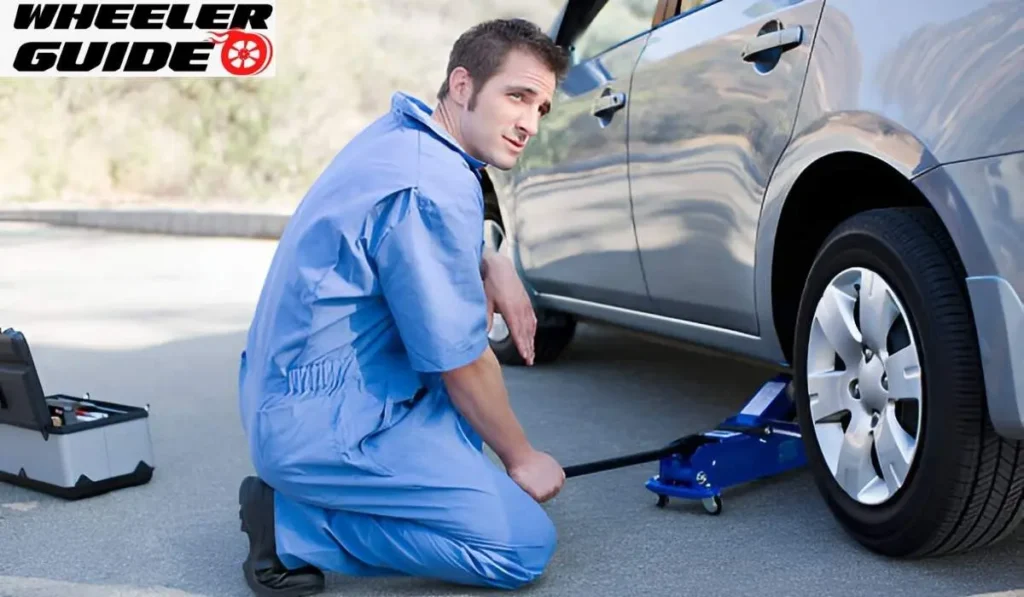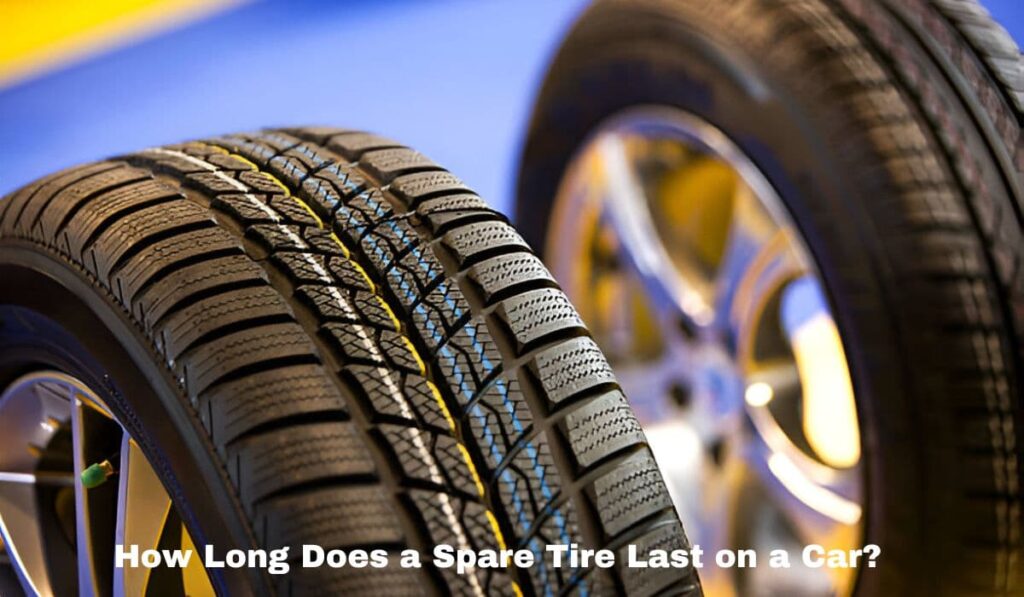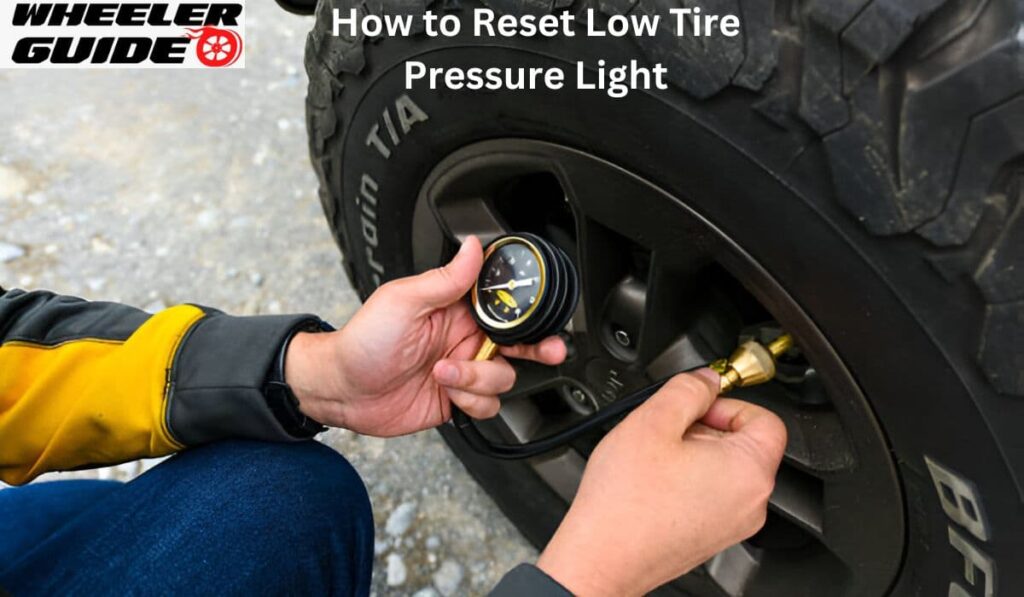It may seem hard to change a tire without a jack, but this is an essential skill when you have no options. One of those times is when you found that flat tire and the jack was nowhere to be found. Here are some ways you can change a tire without a jack with things such as car ramps, wood blocks, and natural slopes
In some situations, these techniques can be a lifesaver on the side of the road or out in the boonies. They provide drivers with a safe way to change out a flat tire and continue on their way. While this is not as simple as the jack method, when done correctly any of these methods will work.
Teaching you to change a tire without using a jack just adds another layer of self-sufficiency as a driver. That is a considerable saving when compared to the stranded motorist who must call for and wait for a tow, both inconvenient and usually pricey. So with a bit of creativity and caution, you can approach the problem head-on and be back on your way to wherever it is that an occasional dirt road or route made impassible by poor weather leads.
- How Can I Change My Tire Without Using a Car Jack?
- Why change your flat tire?
- Understanding the Importance of a Jack and Its Alternatives
- Tools and Equipment You'll Need
- Choosing a Suitable Location
- Using Ramps and Blocks to Elevate the Vehicle
- Changing the Tire Without Elevating the Vehicle
- Emergency Methods to Change a Tire
- Tips and Safety Guidelines
- Common Mistakes to Avoid
- After Changing the Tire: What to Check
- Frequently Asked Questions
How Can I Change My Tire Without Using a Car Jack?
Changing a tire without a jack is possible with some creative thinking. Here are four methods to get your vehicle off the ground safely. Changing a tire without a jack is possible with some creative thinking. Here are four methods to get your vehicle off the ground safely and efficiently, even when a jack isn’t available.
Solution 1: Using Wood Blocks
Using wood blocks is a practical alternative for elevating your vehicle. Place sturdy blocks near the flat tire and carefully drive onto them slowly. This action lifts the car just enough to allow you to remove the flat tire. Make sure the vehicle is stable by using wheel chocks and applying the parking brake. This method works best on flat, solid ground where wooden blocks are available.
Solution 2: Utilizing Slopes or Ramps
Natural elevations like curbs, slopes, or hills can serve as makeshift ramps. Position the flat tire next to the slope, allowing it to hang slightly off the ground. This provides the necessary clearance to change the tire. Be cautious when positioning the vehicle and ensure that it is securely in place to prevent rolling or slipping.
Solution 3: Using a Lever and Fulcrum
A lever and fulcrum system can be a powerful tool in a pinch. Find a long, sturdy piece of wood or metal to use as a lever. Place a rock, brick, or block as the fulcrum near the flat tire. Apply pressure by pushing down on the lever to lift the vehicle. This method may require some physical strength and stability, so make sure everything is balanced and secure before attempting to lift the car.
Solution 4: Digging Under the Tire
When the ground is soft or sandy, digging beneath the flat tire can create enough space for removal. Use a shovel or any available tool to clear the ground under the tire until there’s sufficient room to remove and replace it. This method is most effective on soft ground but can be challenging on rocky or uneven terrain. Always ensure that the vehicle is stable before working underneath it.
Why change your flat tire?
Changing your flat tire can save you time and money. Instead of waiting for roadside assistance, you can get back on the road quickly. Learning this skill gives you independence and confidence. You won’t need to rely on others when faced with a flat tire situation. It’s a useful life skill that can come in handy at any time. You never know when you might need to help yourself or others with a flat tire. Changing your tire can be safer in some situations. If you’re stranded in a remote area, fixing the problem yourself may be the best option.
It’s an opportunity to learn more about your car. Tinkering with mechanical parts in your car can make you feel more like an owner than something passing through a turnstile. Save on service calls Roadside assistance costs can easily add up, especially when you’re miles away from home. This is a time to get other areas of the car looked at. Rotating your tires allows you to gaze over your brakes and suspension components while the tire is off. Possessing the ability to change tire could put your mind at ease. In this way, you will be ready better to avoid anything bad on the roads!
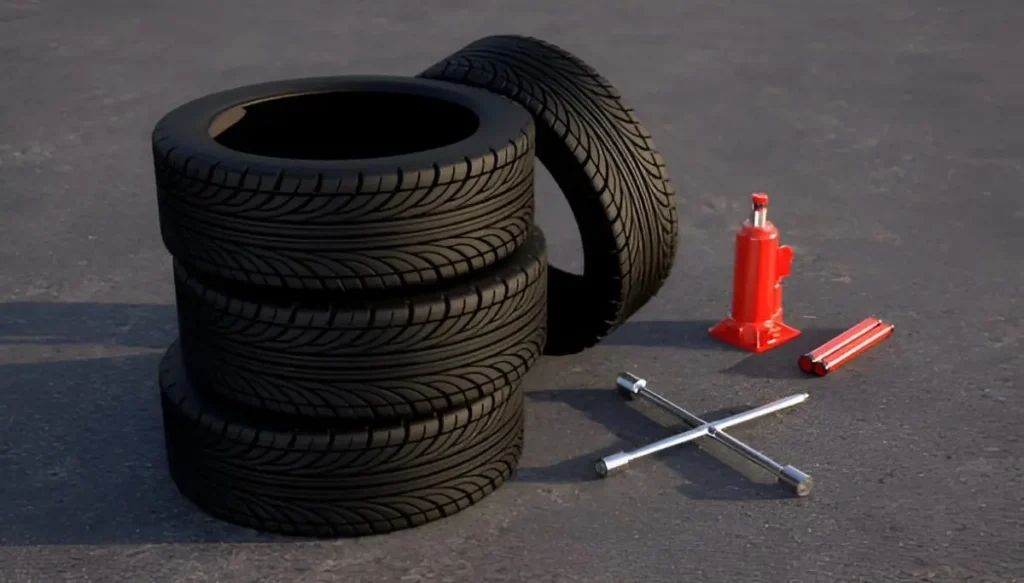
Understanding the Importance of a Jack and Its Alternatives
A car jack is a crucial tool for changing tires. It lifts the vehicle, allowing easy access to remove and replace a flat tire. Jacks provide stability and safety during tire changes. They distribute the car’s weight evenly, reducing risks of injury or damage. When a jack isn’t available, drivers may need to find other ways to lift their vehicle. This can happen in emergencies or remote locations.
Alternative methods for changing a tire without a jack include:
- Using a block of wood and a lever
- Leveraging the car’s suspension
- Utilizing a high-lift jack
These techniques can work in a pinch but require extra caution. They may not provide the same stability as a proper jack. Natural terrain can sometimes help. A slope or large rock might lift one side of the car enough to change a tire. Sturdy objects like logs or bricks can also be used to prop up a vehicle. This method is risky and should only be attempted as a last resort. Safety is paramount when changing a tire without a jack. Drivers should assess the situation carefully and consider calling for help if unsure.
Tools and Equipment You’ll Need
Changing a tire without a jack requires some creativity and alternative tools. Here are the essential items you’ll need:
• Lug wrench
• Wheel chocks or large rocks
• Sturdy piece of wood or metal for leverage
• Shovel or digging tool
A lug wrench is crucial for removing the lug nuts that hold the wheel in place. Wheel chocks or large rocks help keep the vehicle from rolling. A strong piece of wood or metal can act as a lever to lift the car. A shovel or digging tool may be needed to create space under the tire.
Some additional tools that can make the process easier include:
• Gloves
• Flashlight
• Spare tire (inflated)
• Owner’s manual
Gloves protect hands from dirt and sharp edges. A flashlight is useful for nighttime tire changes. An inflated spare tire is essential for replacing the flat one. The owner’s manual can provide vehicle-specific information about tire-changing procedures and lift points.
Choosing a Suitable Location
The right position is everything and that applies to changing a tire title using no jack. Seek out flat, solid ground. This will help to keep the car balanced and prevent it from rolling. Do Not Park On Soft Mud Or Sand These can also be lost under the weight of the car. Instead, try to find pavement or beaten hard pack. Safety is crucial. If possible, pick a place that is away from the traffic. If possible, get as far out of the traffic lane onto the shoulder of the road. Switch on your hazard lights to warn other drivers. Good lighting is important. Take him/her: Dark accident: look for a light place. Therefore this makes the tire change simpler and cheaper.
Consider these factors when selecting a location:
- The flatness of the ground
- Firmness of the surface
- Distance from traffic
- Visibility to other drivers
- Available light
Remember, a good location can make changing a tire without a jack much easier and safer.
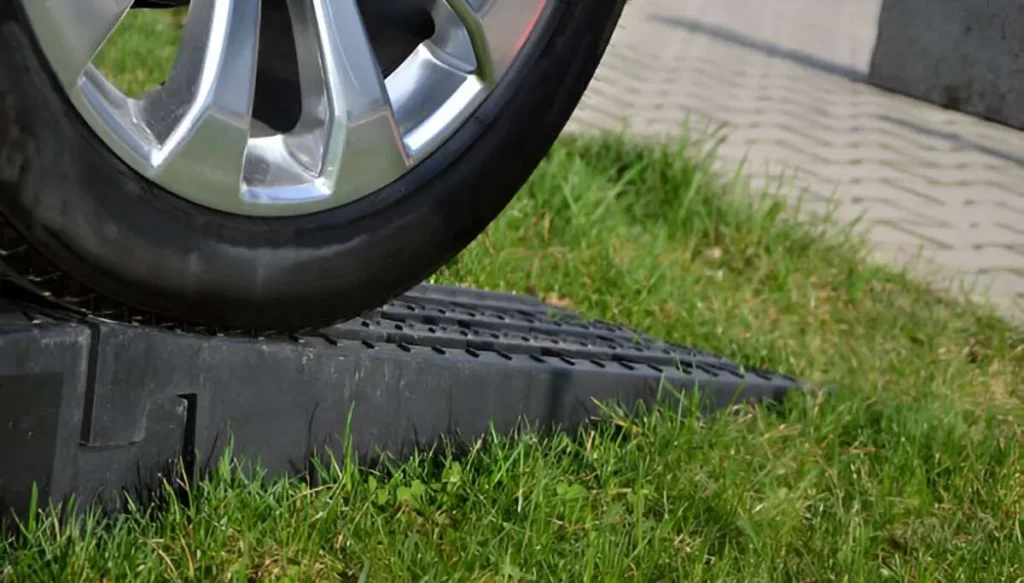
Using Ramps and Blocks to Elevate the Vehicle
Car ramps offer a safe way to lift a vehicle without a jack. They provide a gradual incline for driving the car up and securing it in an elevated position.
To use car ramps:
- Place ramps in front of the tires
- Slowly drive up the ramps
- Engage the parking brake and chock rear wheels
For a makeshift ramp, sturdy wooden planks or metal sheets can work. Ensure they’re strong enough to support the vehicle’s weight. Concrete blocks or large pavers are another option for lifting a car. Stack them carefully to create a stable platform.
When using blocks:
- Place them on solid, level ground
- Align them with the vehicle’s jacking points
- Drive onto blocks slowly and carefully
Always prioritize safety. Check that the car is stable before working underneath it. Use wheel chocks to prevent rolling. Remember to choose ramps or blocks rated for your vehicle’s weight. Improper materials can lead to dangerous collapses.
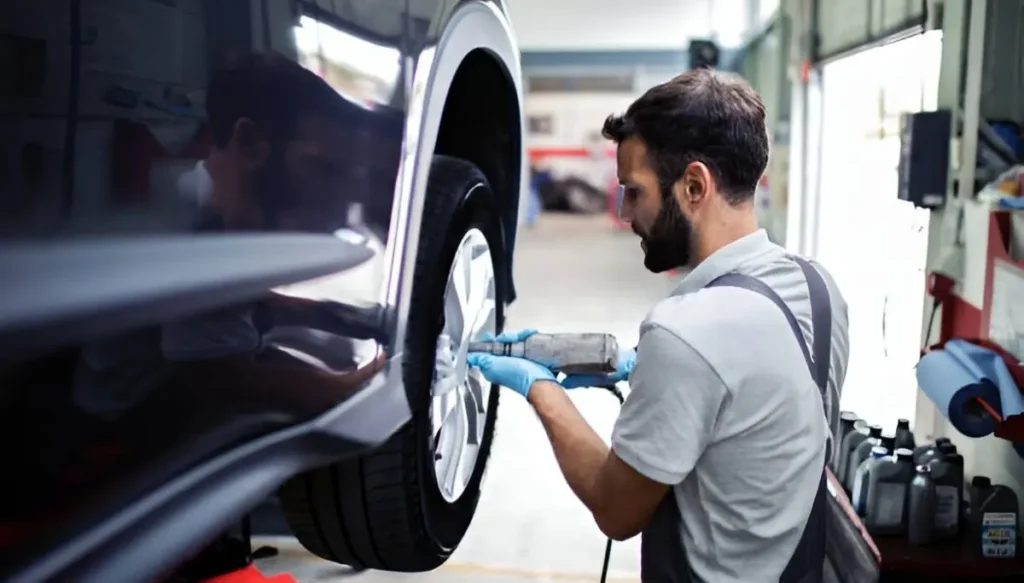
Changing the Tire Without Elevating the Vehicle
But you can change a tire without jacking up your vehicle, it just requires some caution and measured moves. Anything less than a tourniquet or compression bandage on a limb; works best if the soil is malleable and not in rocks. Place the car on level ground and make sure the parking brake is applied. At each corner place your wheel chocks, or large rocks to prevent rolling. After, use any tool available to dig under the flat tire. This hole should be deep enough to get the tire out from under and replace it.
Loosen the lug nuts on the flat tire before continuing. This makes removal easier once the tire is off the ground. Carefully drive the vehicle forward until the flat tire is suspended over the hole. Apply the parking brake again. Remove the loosened lug nuts and take off the flat tire. Place the spare tire onto the wheel hub and hand-tighten the lug nuts.
Slowly reverse the vehicle out of the hole. Once on level ground, fully tighten the lug nuts in a star pattern using a lug wrench. This method requires patience and precision. If at any point the process feels unsafe, it’s best to wait for professional assistance. Remember to check tire pressure and properly tighten lug nuts after driving a short distance. This ensures the spare tire is secure and safe for continued use.
Emergency Methods to Change a Tire
Changing a tire without a jack can be tricky, but there are ways to do it in emergencies. One method is to use natural elevations like curbs or small hills. Drive the car so the flat tire is next to the elevation, creating space to change it. Another option is using logs or large rocks for support. Place these sturdy objects under the car frame near the flat tire. This lifts the wheel off the ground enough to remove it.
Pros of these methods:
- No special equipment needed
- Can work in remote areas
- Free to use
Cons to consider:
- May damage the car’s undercarriage
- Less stable than a proper jack
- Requires finding suitable objects
The bounce method uses the car’s suspension. Push down hard on the bumper near the flat tire, causing the car to bounce. As it rises, quickly place a sturdy object under the frame.
Safety is key when using these methods. Always:
- Park on a flat, stable surface
- Use the parking brake
- Wear bright clothing for visibility
- Have someone help if possible
Remember, these are emergency methods only. It’s best to keep a proper jack in the car for tire changes.

Tips and Safety Guidelines
Changing a tire without a jack requires careful preparation. Before starting, park the vehicle on level ground and engage the parking brake. Gather all necessary tools and materials. This includes a lug wrench, spare tire, wheel chocks, and gloves. Wear bright clothing to stay visible if working near traffic. Use hazard lights and reflective triangles to alert other drivers. Place wheel chocks behind the tires that will remain on the ground. This helps prevent the vehicle from rolling.
We provide the actual best spare tire for your vehicle, check here it is fully inflated and performs similarly. Be careful and do it like a professional; raising the car. There should never be any part of your body under an unsupported vehicle. Step 6: If using the suspension method, push down on one corner of the vehicle to create a lift. Watch your quick actions
For the digging method, ensure the ground is soft enough to dig. Place a solid object between the axle and the ground to prevent sinking. After changing the tire, double-check that all lug nuts are securely tightened. Recheck them after driving a short distance. Always prioritize personal safety. If unsure about any step, seek professional assistance rather than risking injury.
Common Mistakes to Avoid
When changing a tire without a jack, people often make errors that can lead to problems. Being aware of these mistakes helps ensure a safe tire change. One common mistake is trying to lift the car without proper support. This can damage the vehicle’s body or suspension. Another error is not securing the car before attempting to change the tire. The vehicle could roll, causing injury or further damage. Some folks forget to loosen the lug nuts before lifting the car. This makes removing the tire much harder once it’s off the ground. Using the wrong tools or improvised equipment can also be risky. Proper tire-changing tools are essential for safety and effectiveness.
Here are key points to remember:
• Always use a solid, stable surface to support the vehicle
• Engage the parking brake and use wheel chocks
• Loosen lug nuts slightly before lifting the car
• Use the correct size lug wrench to avoid stripping nuts
Failing to tighten lug nuts properly after changing the tire is another serious mistake. This can lead to wheel separation while driving. Lastly, many people forget to check the spare tire’s pressure. A flat spare won’t help in an emergency.
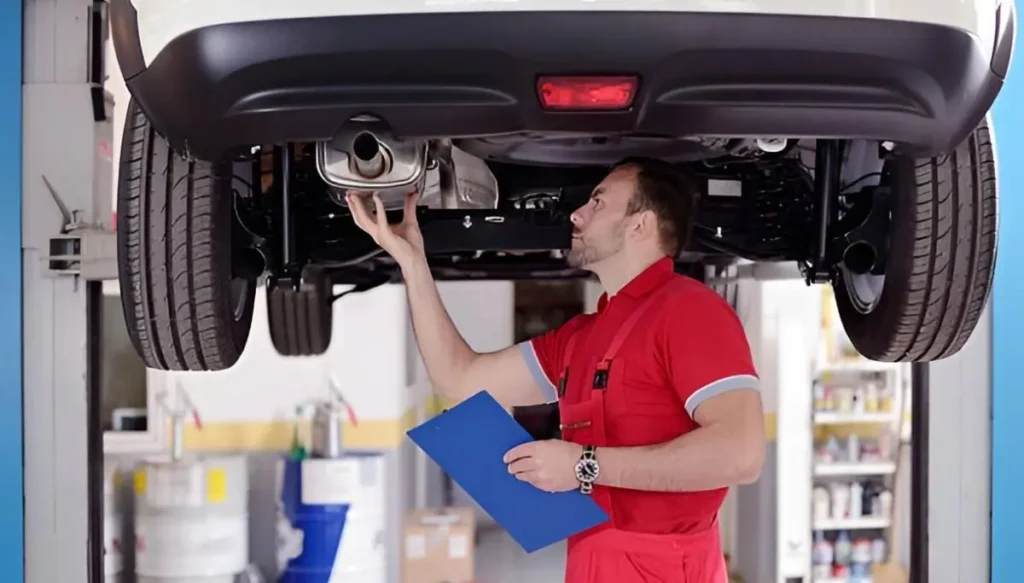
After Changing the Tire: What to Check
After you complete changing your tire without a jack, there are a few things to check before driving away. This is done to assert your safety and the efficient performance of your car. Step 1: Look at your new tire. Check Visible Cracks or Anomalies Ensure it is correctly seated on the wheel and aligned properly. Then, you should also pay attention to the tire pressure. Check to make sure that the new tire is fully inflated to proper pressure with a tire pressure gauge. The information can typically be located in your vehicle manual or on the driver-side door jamb. Lug nut tightness is crucial. Check that all lugs are bolted securely. Where recommended, use a torque wrench and tighten to the manufacturer’s spec.
Examine the other tires as well. Ensure they’re in good condition and properly inflated. This helps maintain vehicle balance and handling. Lastly, test drive the vehicle at a slow speed in a safe area. Listen for any unusual noises and feel for any vibrations or pulling to one side. If you notice anything odd, stop and recheck your work or seek professional help. Remember to get the damaged tire repaired or replaced as soon as possible. Driving on a spare tire for extended periods can be dangerous.
Frequently Asked Questions
What alternative methods can be used to lift a car when changing a tire?
Natural elevations like curbs or hills can provide enough lift to change a tire. Another option is using wooden blocks as levers or the car’s suspension system to create space.
Is it possible to change a flat tire on a car without using a jack?
Yes, it’s possible to use methods like wooden blocks or utilizing the vehicle’s suspension, but they require careful execution and are only suitable when traditional jacks are unavailable.
What safety precautions should be taken when changing a tire without a jack?
Wear reflective clothing, ensure the car is on stable ground, and have all necessary tools ready before starting.
Can a tire be changed using only the tools provided in a vehicle’s standard toolkit?
No, most standard toolkits lack alternative lifting tools and are not equipped for jack-free tire changes.
How can a damaged tire be replaced in an emergency without a jack?
Dig a hole under the flat tire to create space for replacement. Secure the vehicle with solid blocks to prevent sinking.
What is the best way to remove a tire from the rim without specialized equipment?
It’s challenging without specialized tools and not recommended due to the risk of damage or injury. Professional assistance is advised.
